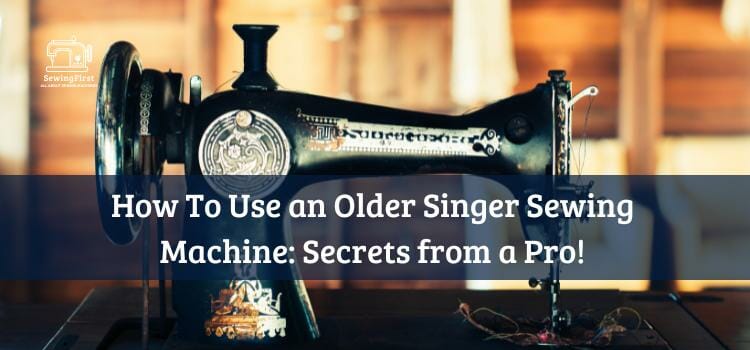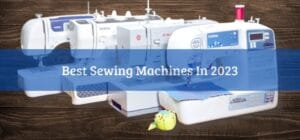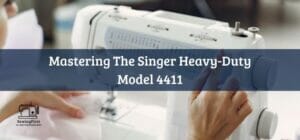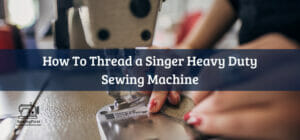Hey everyone, have you ever wanted to learn how to use an older Singer sewing machine? If so, you’re in luck! I’m here today to help take the mystery out of using one of these amazing machines. Sewing is a fantastic skill that allows us to create beautiful clothing and accessories from home. With just a few simple steps, we can get our hands on this versatile tool and start creating.
When it comes to vintage or antique machines, they are true works of art! Not only do they add character and charm to any room, but when paired with modern technology, these classic tools can be used for all sorts of projects. Whether you’re looking to make a quilt or sew a dress, learning how to use an older Singer sewing machine will give you the skills necessary to complete your project with ease.
So let’s begin our journey into the world of crafting and see what kind of wonderful things we can create together! By the end of this article, you’ll know exactly how to set up and operate your new-to-you Singer sewing machine like a pro. So grab your supplies and let’s get started!
Related Topic: How Much is an Old Singer Sewing Machine Worth? The Ultimate Guide
Table of Contents
ToggleHistory Of Singer Sewing Machines
I’m sure many of us have heard of Singer sewing machines and their rich history. Singer has been around since the mid-1800s and is still producing quality sewing machines today. They are a go-to for both novice sewers, as well as professional seamstresses and tailors, who rely on them to create beautiful garments.
For those who love vintage items, there’s nothing quite like owning an antique Singer sewing machine! Sewing enthusiasts from all over the world admire these pieces of craftsmanship for their beauty and efficiency.
Singer has produced several models throughout the years. Some were designed with a specific purpose in mind while others could be used for general stitching projects. The company also introduced some innovative features that made it easier for people to use their products. From adjustable tension settings to automatic thread cutters and built-in bobbins – they definitely kept up with modern times.
All this makes me appreciate my own Singer even more. I can’t help but marvel at how far we’ve come when it comes to technology and design advancements over time – and yet, we still cherish our old faithful machines just like back in the day! Now let’s explore different models of older singer machines, which will give us an even better understanding of how far we’ve come.
Different Models Of Older Singer Machines
As the saying goes, “The more things change, the more they stay the same,” and this is certainly true for Singer sewing machines. Whether it’s a vintage Singer machine from years past or one of today’s modern models, there are numerous types of machinery available to choose from.
When selecting an older Singer sewing machine, you should consider what type best suits your needs. One option is a treadle machine – these were popular during the early 1900s and still offer excellent performance today.
This model uses foot power to operate instead of electricity but can easily be adapted with a motor if desired. Additionally, some collectors prefer these antique pieces as conversation starters in their home décor.
For those who want something a little newer, several vintage models manufactured between 1930 and 1950 are great options due to their reliability and convenience features. These include the Featherweight 221K which has been dubbed “the perfect portable” and the 15-91 which was designed for heavier fabrics such as denim.
Regardless of which kind of Singer machine you choose, all require certain accessories for operation such as needles, scissors, pins, and threaders.
Accessories Needed For Operation
Using an older Singer sewing machine is a great way to get creative with projects. To operate the machine, you’ll need some accessories. If your machine has an electric motor, make sure it works properly before beginning any project.
Automatic needle threaders can be helpful when working on intricate pieces of fabric. Featherweight models often require specific needles and bobbins in order to work correctly. You may also want to purchase a fabric swatch pack so you can test out various fabrics before starting a project.
If you have any questions while setting up your machine or during use, don’t hesitate to ask for help! Many online forums offer valuable advice from experienced sewists who are familiar with different types of machines and fabrics.
Just remember that even though there are many differences between old and new models, each one provides its own set of unique possibilities for creativity–so go ahead and explore them all! With the right equipment and knowledge at hand, creating custom designs will become easier than ever before!
Setting Up The Machine
Setting up an older Singer sewing machine can seem like a daunting task. It’s almost as if the antique machine has been alive for many years, waiting to be brought back to life again! But don’t worry, it’s not too difficult and with a few simple steps, you’ll have your vintage beauty humming away in no time.
First things first are getting familiarized with all of the parts that make up your Singer sewing machine:
1. Bobbin winder
2. Presser foot lever
3. Handwheel
The bobbin winder slots into place at the top right of the machine, while the presser foot lever lowers or raises the needle plate depending on what type of stitch you’re using. On the left side of your singer antique sewing machine should be the hand wheel which controls how fast or slow your thread runs through when stitching.
The next step is ensuring that everything is working properly before starting any project – after all, this manual sewing machine is probably several decades old so some TLC may be necessary! Check each part carefully to make sure they are functioning correctly; replace any broken components if needed and give them a good clean-up (a soft cloth will do). When you’re satisfied that everything looks good, then it’s time to move on to threading your Singer sewing machine ready for action!
Threading The Machine
Threading a Singer sewing machine is the first step to getting started. Whether you have an antique treadle, electric or mechanical machine, threading your machine can be a bit tricky at first. To get started, take a look at the manual that was included with your sewing machine.
It should contain information, including diagrams and instructions on how to thread it correctly. If you don’t have the manual anymore, there are online resources available that will guide you in threading your specific model of Singer machine.
To identify which type of Singer machine you own, locate the serial number stamped onto the back of your machine’s body. Once you know what kind of Singer sewing machine you’re working with, find out if it has any unique features that require special attention when threading it. For example, some treadle machines may need extra care due to their age and lack of parts availability for repair purposes.
Once you’ve found all the information needed regarding your particular Singer sewing machine, make sure all necessary accessories like bobbins and needles are readily available before beginning to thread it up!
With careful prep work and proper guidance from manuals or online sources about your model of Singer sewing machine – even novice sewers can easily learn how to successfully thread their beloved machines! Now let’s move on to adjusting tension settings.
Adjusting Tension Settings
Adjusting the tension on an older Singer sewing machine is like a journey back in time. It’s a reminder of how far the sewing industry has come – from vintage Singers to modern machines with all kinds of bells and whistles. As I adjust my black Singer, I’m reminded that these affordable machines have been around for generations, providing reliable service and helping people express themselves through fabric and thread.
To start adjusting the tension settings, take off the needle plate cover by unscrewing it counterclockwise. Once open, you’ll see two discs: one with numbers (the upper disc) and another below it without any markings (the lower disc).
To increase or decrease the tension of your stitches, slowly rotate either disc until desired tension is achieved as indicated by your test sample. After making adjustments, replace the needle plate cover screw clockwise to secure it shut before using it again.
Now that we’ve adjusted our pressure settings successfully, let’s explore some exciting ways to use them!
Selecting Stitches And Patterns
Now that you’ve adjusted the tension settings on your Singer sewing machine, it’s time to start selecting stitches and patterns. Many modern machines come with an array of options, while older models have more basic stitch selection capabilities. But no matter what type of machine you’re using, understanding how stitching works can help make creating beautiful garments a lot easier.
When choosing a pattern for any project, consider both the purpose and design of the item being made. If you’re making something like curtains or drapes that need to hang evenly, use straight topstitching along the edges instead of zigzag stitching which may cause puckering in heavier fabrics.
For projects such as pillows or quilts, decorative stitches will add texture and interest to the finished product. Once you decide on a pattern, threading the machine correctly is essential for achieving consistent results.
Be sure to choose quality stitching thread that matches your fabric weight and color so there won’t be issues when it comes out of production.
Whether you’re working with a hand-me-down machine or one from a repair shop, practice makes perfect! Selecting different types of stitches and mastering their use takes time but once you get comfortable with them you’ll soon find yourself ready to tackle bigger challenges like intricate embroidery designs or adding trims to clothing items.
With some patience and proper maintenance techniques, even an old Singer sewing machine can produce amazing results – just take things one step at a time! Ready for your next challenge? Let’s move on to preparing fabric for sewing!
Preparing Fabric For Sewing
Let’s take a look at my great-grandmother’s antique hand-sewing machine, which has been sitting in the attic for years. This friendly machine is an older Singer model, with a serial number that dates it to around 1925. Even though this type of model isn’t used today, I can still use it to sew fabric! Before getting started on any project, I have to prepare the fabric first.
First, I need to decide what sort of fabric I want to work with and make sure that it matches up with the kind of thread and needle that I am using. To ensure accuracy when measuring out the piece of cloth, I will use a ruler or tape measure. When cutting out the material, there are some tips that come in handy:
- Use sharp scissors so they stay clean and don’t damage the fabric fibers.
- Make sure not to stretch or pull the material while measuring or cutting as this could distort its shape after washing.
- Lastly, always cut from the selvage edge (the finished edges) of your fabric as it won’t fray like other parts may do when washed.
After having cut out all pieces necessary for a project, ironing them is essential before beginning construction. Ironing helps flatten wrinkles and gives more stability while sewing – ensuring accurate results each time!
It also helps keep seams straight and pressed open during assembly steps if needed too. If you’re working with delicate fabrics such as silk satin or velvet be extra careful when pressing; low temperatures settings should be used and press cloths placed between garment pieces and iron to avoid shine marks left behind by heat presses directly onto the garment’s surface area itself. With these few simple steps, my vintage Singer Sewing Machine is ready for action!
Operating The Foot Pedal
Operating the foot pedal of an older Singer sewing machine is fairly simple. Once you’ve plugged in the machine and made sure it’s turned on, all that’s left to do is press down on the pedal with your foot.
While there are some machines that have LCD screens and a variety of settings, older Singer models don’t have any bells or whistles so they’re easy to use. Taking this enthusiastic approach will make learning how to use these beautiful machines even easier!
Of course, the foot pedal serves as more than just a way to turn on your machine for stitching thread; it also helps you control the speed at which your needle moves. Depending on what type of fabric you’re working with, you may want to adjust the speed accordingly by pressing harder or softer on the foot pedal.
No matter how experienced you are with using a Singer machine, always be sure to practice caution when operating your machine.
That means following safety guidelines such as unplugging it after each use, not leaving threads around it while in operation, and never ever touching the needle while it’s still moving. With this knowledge in mind, let’s move on to troubleshooting common problems associated with using our beloved Singers!
Troubleshooting Common Problems
Troubleshooting common problems with your Singer sewing machine can sometimes be a daunting task. But, it doesn’t have to be! An understanding of the mechanics and design of these amazing machines will help you tackle any challenge that may arise. With a few simple tips and tricks, soon enough you’ll have become an expert in troubleshooting common issues.
One of the most helpful methods is by finding out the letter prefix on your vintage or antique Singer sewing machine. This code allows you to identify its approximate age and model type -with each having different features- allowing you to better diagnose the problem at hand.
Many female demonstrators from the time period worked for Singer and had access to detailed manuals which are now available online; a great resource for diagnosing older models. Alternatively, there are still many experienced antique dealers who specialize in such repairs if needed.
When it comes to repairing a damaged machine, some parts can usually be replaced easily while others require more complex adjustments or replacements. When attempting DIY repairs make sure all screws are tightened properly as loose connections often lead to further complications down the line.
Also, always use genuine replacement parts when possible as they offer superior performance over generic alternatives (which might even damage your machine!).
With this knowledge under your belt, you’re well on your way toward becoming a master mechanic capable of identifying and fixing minor hiccups yourself quickly and easily without requiring outside assistance! Next up: cleaning and maintenance tips – essential components of ensuring top-notch performance from any sewing machine regardless of its age or model type.
Cleaning And Maintenance Tips
It’s important to keep your Singer sewing machine clean and well-maintained. Electronic machines are often more innovative than their older counterparts, but vintage models from the 20th century still have plenty of life in them! Here are some tips on cleaning and maintaining an older Singer model:
- First off, you should always start by removing all lint or debris from the machine, as this can affect its accuracy of production. You can use a brush or vacuum cleaner for this job.
- Additionally, it’s also best to lubricate all moving parts every six months with oil specifically designed for sewing machines. If you’re not sure how to do this yourself, visit a local sewing machine repair shop – they’ll be able to help you out!
- Finally, it’s worth occasionally checking that the tension is correct; if it isn’t then your fabric won’t stitch properly. This requires adjusting several internal mechanisms and so again, I’d recommend taking it to a professional if you don’t feel confident tinkering around with the inner workings of your machine.
With these few simple steps taken care of regularly, you will ensure many years of reliable service from your trusty old Singer! Now let’s move on to accessorizing your Singer machine…
Accessorizing Your Singer Machine
Did you know that Singer Sewing Machines have been around since 1851? With such a long, rich history it’s no wonder they are so popular. Accessorizing an older Singer machine can give you beautiful bargains and help design sleeker projects. There is something special about the look of these classic machines that real collectors appreciate.
Advances in technology mean more accessories available for your older model than ever before! If you want to upgrade your machine, there are many retrofit kits from which to choose. And if you’re looking for some extra inspiration, check out the International Sewing Machine Collectors’ Society website for ideas on how to customize your vintage piece.
From new needles and bobbins to cables and cords – accessorizing an older Singer sewing machine will bring a whole new level of enjoyment to your craft or hobby. It’s time to get creative with this timeless classic!
Upgrading Your Older Model
I’m all about the nostalgia of using an old Singer sewing machine. The older models have a certain charm, and I love how it puts my own skills into creating something beautiful in the foreground. But when it comes to the accuracy of production, there’s nothing like having a newer model with some upgraded features.
Fortunately, you don’t need to purchase a brand-new black machine just yet! There are many ways to upgrade your old one without spending too much money.
For example, visit annual sewing machine auctions or look at online forums for advice on where to find parts and repair services that can get your vintage sewing machine back up and running smoothly again.
You’ll be amazed by what improvements you can make with just a few simple modifications! Now you’ll be able to produce even more detailed projects with greater accuracy and control than ever before – all while keeping the nostalgic feel of your beloved older sewing machines alive and well.
Where To Find Parts And Repair Services
When it comes to finding repair services and parts for an older Singer sewing machine, you have a few options. First and foremost, if you’re lucky enough to live near one of the premiere sewing machine collectors in the country, then they just might have what you need.
The Annual Sewing Machine Auction is a great place to start looking – here you can find all sorts of antique Singer machines as well as contemporary ones that still use the same parts. If you don’t know any local collectors or aren’t able to attend a big auction, then your best bet would be to do some research online.
There are plenty of websites dedicated specifically to repairing vintage Singer machines that may offer original parts or compatible replacements with detailed instructions on how to install them. With a bit of digging, you should be able to track down whatever part or service you require for your beloved old machine!
Using A Manual Or Online Tutorials
To get started with your older Singer sewing machine, you should consider using manual or online tutorials. Manuals are great if you want to learn the ins and outs of each part of the machine. They provide detailed instructions that can help any sewist understand how it works.
If you’re looking for more up-to-date information, then online tutorials could be just what you need. With these resources, women all over the world have access to the latest techniques and tips on mastering their machines.
Online tutorials offer step-by-step guidance through every feature of your Singer sewing machine. You’ll find video demonstrations as well as written guides that show exactly which parts do what and how to use them properly.
It’s easy to follow along from start to finish so even novices can gain confidence in operating their machines quickly. Additionally, many online courses focus specifically on working with vintage models like yours – giving you plenty of useful advice about troubleshooting issues or making repairs when necessary.
And don’t forget about forums! Many experienced sewists are happy to share their knowledge and answer questions from fellow enthusiasts. You may be surprised at how much help is available out there – not only regarding specifics about your particular model but also general tips for better results when stitching fabric together.
So whatever direction you decide to go in terms of learning how to use your Singer sewing machine, make sure you explore all the options before heading off into uncharted territory!
Conclusion
When I was first handed my mother’s Singer sewing machine, I had no idea how to use it. All of the knobs and switches were confusing and overwhelming! But with some time and patience, I figured out all of the steps necessary for basic operation.
Now that I’ve mastered this process, sewing is a joyous activity for me—it’s like getting lost in a creative world where nothing else matters but you and the fabric.
My experience has taught me one thing: Never be afraid to try something new. If you put your mind to it, anything is possible.
The same holds true when learning how to use an older Singer sewing machine; don’t let its age or unfamiliarity intimidate you. With a bit of guidance from manuals or online tutorials, anyone can learn how to operate these machines quickly and easily.
FAQs
How do you sew with old Singer sewing machine?
1. Make sure the machine is plugged in and the power switch is switched to the “On” position.
2. Thread the machine. Insert the spool of thread into the holder, pull the thread through the take-up lever, thread the needle, and pull the thread through the tension discs.
3. Select the stitch you need for the project. On an old Singer sewing machine, the stitch selection is done by turning the dial on the front of the machine.
4. Place the fabric under the presser foot and lower the foot.
5. Place your hands on the handwheel and turn it counterclockwise to lower the needle into the fabric.
6. Push the foot pedal or hand crank to start the machine.
What do I do with an old Singer sewing machine?
You have several options for what to do with an old Singer sewing machine. You could use it as intended, either by yourself or by passing it on to someone else who can use it to sew. Alternatively, you could use it as a decorative item, either by displaying it in your home or by upcycling it into something else entirely. You could also sell it either at a yard sale or online.
Are old Singer sewing machines any good?
Singer sewing machines can be very good. They have been around for more than a century, and many of their machines are still in perfect working order. Older Singer machines may require some maintenance, but they can be great for those who are looking for an older machine with a unique, classic style.
Are vintage Singer sewing machines easy to use?
Yes, vintage Singer sewing machines are typically quite easy to use. They have a straightforward design and are generally very reliable. Many vintage Singer machines have basic features that are easy to understand and use.
How much is an old Singer sewing machine worth today?
The value of an old Singer sewing machine depends on its age, condition, and model. Generally, an antique Singer sewing machine in good condition could be worth anywhere from $50 to over $500.
Why are old sewing machines better?
Old sewing machines are often considered better than modern machines because they are more durable, have fewer mechanical issues, and can be more easily repaired or maintained. Additionally, many people find the heavier metal construction of older machines to be more precise, and they often come with more features and accessories than more modern machines.





